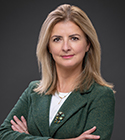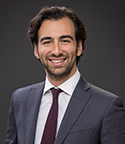This article was originally published on
Paperjam. Read the article
here.
“When it comes to sustainable finance, Europe continues to lead the way, and the Wealth Assurance sector within it.”
Legacy. Sustainability. Stability. These are the key outcomes not just for ESG solutions, but also for the increasingly popular Wealth Assurance, also known as Unit-Linked Life Insurance across Europe or Private Placement Life Insurance (PPLI) more globally. It is perhaps for that reason that we are seeing HNW families and their advisers across the world rely on Wealth Assurance solutions as they seek to integrate sustainable investing into their financial portfolio.Legacy. Sustainability. Stability. These are the key outcomes not just for ESG solutions, but also for the increasingly popular Wealth Assurance, also known as Unit-Linked Life Insurance across Europe or Private Placement Life Insurance (PPLI) more globally. It is perhaps for that reason that we are seeing HNW families and their advisers across the world rely on Wealth Assurance solutions as they seek to integrate sustainable investing into their financial portfolio.
The ESG corner of asset management has been slowly establishing itself over the last decade, but those across the financial world would acknowledge that there has been a notable gear change more recently. An annual study by Barclays Private Bank, Campden Wealth and Global Impact Solutions found that 86% of wealthy individuals, family offices and foundations around the world believe their capital will be essential in tackling climate change because governments are not doing enough[1].
This comes in different forms. A group of nine philanthropic foundations recently committed what has been reported as the largest ever donation to nature conservation, pledging $5bn to finance the protection of 30% of land and sea by the end of the decade via the Protecting our Planet challenge. But these attitudes are also being reflected in HNWs investment strategy and decision making. The proportion of impact investment in portfolios reached 41% this year, up from 36% in 2020 and 20% in 2019. In addition, 18% of the aforementioned survey’s respondents now invest primarily in the impact segment, compared with 13% in 2019.
It is evident that “ESG-based investing is now widely adopted by traditional investors in the private wealth and family office space”. Crucially, those solutions in which HNWs want to hold their assets must be adaptable and agile enough for this asset shift. It is for this reason that Wealth Assurance continues to be top of mind.
Europe at the regulatory vanguard
When it comes to sustainable finance, Europe continues to lead the way, and the Wealth Assurance sector within it. The EU commission action plan on sustainable finance embodies the matrix of intent for the definition of a new EU legal framework on sustainability, and it is viewed by many around the world as a gold standard.
The action plan to which the European Commission is committed aims to reroute capital flows towards a more sustainable economy, mainstreaming sustainability into risk management and fostering transparency and long-termism. But the process of how its ambitious plans are to be realised is complex, reliant on a selection of key regulatory instruments - Sustainable Finance Disclosure Regulation (SFDR), the Regulatory Technical Standards (RTS), European Taxonomy, and the Insurance Distribution Directive (IDD). But each plays a fundamental role in enabling the Wealth Assurance sector to act as a preferred gateway for impactful investing.
The Wealth Assurance gateway
Sitting at the heart of the European financial sector is Wealth Assurance, and it is the gateway through which an increasing number of HNWs and their advisers are choosing to activate their ESG investing strategy.
While determined to deliver more meaningful environmental impact, those at the higher end of the wealth scale have a set of structural requirements that remain constant. Their lifestyles are complex and the solutions which they use need to be able to be tailored to their unique situation. Crucially, the Wealth Assurance sector has embraced the European Commissions’ regulatory drive toward sustainable finance, continually developing its offering to ensure that it remains the most suitable way through which HNWs and their advisors can execute their non-financial goals and aspirations as part of their financial planning.
The SFDR together with the Regulatory Technical Standard (RTS) still in the process of being adopted by EU Commission, sets the specific rules applicable to precontractual information to be provided to clients, as well as the content of the periodical reports that are required to be sent to policyholders throughout the life of their insurance contract. This new set of rules shall apply to financial products (including Investment Based Insurance Products) issued by Financial Market operators (ex. insurance companies) and distributed by financial advisors (ex. insurance intermediaries or insurance companies in case of direct distribution).
The SFDR classifies sustainable products in two groups, Articles 8 and 9. The former refers to so called “light green”, for financial products that embody environmental or social characteristics but do not have as its objective a sustainable investment. This might occur if the product does not directly invest, or invests only partially, in sustainable investments. The latter, also known as “dark green” financial products, do have sustainable investment as their objective. This means that the vehicle invests in an economic activity that contributes to an environmental or social objective and that the investee company follows good governance practices.
The RTS published by the European Supervisory Authorities to implement SFDR, is in the process of setting up the rules applicable, among others, to the so-called MOP, or Multi-option products. This might grant wealth assurers the possibility to offer investment-based insurance solutions which include, among others, sustainable investment options qualified under article 8 – light green – and article 9 – dark green. This will allow the creation of efficient, diversified and sustainable investment portfolios, steering the right level of ESG integration.
The European Taxonomy that will enter into force in 2022, provides a classification system, a common language to identify to what degree economic activities can be considered environmentally sustainable. It is among the most advanced in establishing a common language on sustainability. Various taxonomies have been agreed around the world, but their integration is still being discussed. For example, China and Japan have already defined their own taxonomy related to sustainability. Other countries such as Canada and Indonesia are working on their development. The US has also recently reached a consensus in proceeding with the definition of its own taxonomy.
The IDD implementing regulation has also been amended in order to require each provider and distributor of investment-based insurance products to collect and process client’s preferences in terms of sustainability. These amendments will enter into force on August 2022 and will change the way insurance products will be distributed, requiring a suitability assessment in relation to the ESG preferences of clients.
Conclusion
The rationale behind ESG pillars is to build more sustainable asset portfolios, which take into account a long-term investment horizon spanning multiple generations and a life insurance product is by definition a sustainable solution, given its purposes and characteristics.
Aiming to protect, preserve and pass on legacies to the next generations is where the two converge, a fact that will help secure substantive progress in the awareness and success of the sustainable finance sector. Bloomberg Intelligence predicts that Global ESG assets are on track to exceed $53 trillion by 2025, representing more than a third of the $140.5 trillion in projected total assets under management[2].
But as regulations continue to evolve and expectations shift, investment products must reflect that. We all have a responsibility to help capture the potential of sustainable investing and while there has undoubtably been huge progress, much remains to be done if we’re going to do our bit to weather the climate crisis. If HNWs are going to be able to maximise the impact of their wealth, Wealth Assurance solutions will play a crucial part.
 Maria Cristina Boscolo Berto
Maria Cristina Boscolo Berto
Director, Regional Head of Wealth
Structuring Solutions
Lombard International Assurance Filippo Mancini
Filippo Mancini
Wealth Planner
Lombard International Assurance